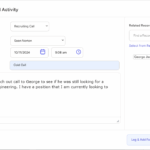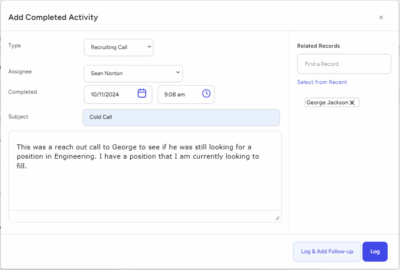Hiring, especially for small businesses, is not easy. This is true regardless of the state of the economy or the type of job market employers are facing. That’s because organizations always want to hire the best, which typically means the top 5% to 10% of the candidates. This is where hiring software for small businesses is a key factor for experiencing more success.
What platforms are used for hiring?
When it comes to hiring, there are various platforms and channels available to connect with potential candidates. These platforms offer different functionalities and reach, allowing businesses to tailor their approach based on their hiring needs. Below are five common platforms used for hiring.
#1—Job boards
Job boards are online platforms where employers can post job openings and candidates can search and apply for jobs.
Popular job boards include Indeed, LinkedIn, Glassdoor, and CareerBuilder. These platforms offer a wide reach and attract a diverse pool of candidates.
#2—Social media
Social media platforms, such as LinkedIn, Facebook, and Twitter, have become valuable tools for hiring.
They allow businesses to showcase their employer brand, engage with potential candidates, and advertise job openings. Social media provides an opportunity to reach passive job seekers and tap into professional networks.
#3—Company websites
Many businesses have dedicated career pages on their websites where they display job listings and provide information about their company culture and values. Company websites are particularly useful for attracting candidates who are specifically interested in working for that organization.
#4—Professional networking sites
Professional networking sites like LinkedIn are designed for professional connections and can be powerful tools for hiring. These platforms allow businesses to search for and connect with potential candidates, view their professional profiles, and engage in direct communication.
#5—Hiring software
Hiring software provide comprehensive solutions for managing the entire hiring process.
They offer functionalities like job posting, resume parsing, candidate tracking, interview scheduling, and collaboration tools. These platforms streamline hiring and consolidate all hiring activities in one centralized system.
Businesses often use a combination of these platforms to maximize their reach and find the right candidates. The choice of platforms depends on factors such as the target audience, job requirements, budget, and time constraints. By utilizing a diverse range of hiring platforms, small businesses can effectively connect with candidates and optimize their recruitment efforts.
While there are many options, the platform upon which we’ll be focusing is hiring software for small businesses. However, the phrase “hiring software” can be applied to a wide range of tools.
What is hiring software called?
Hiring software is commonly referred to as applicant tracking system or ATS. An applicant tracking system is a type of software that helps businesses streamline and manage their recruitment process. It provides features such as job posting, resume parsing, applicant tracking, candidate management, interview scheduling, and collaboration tools.
ATS allows businesses to collect, organize, and review candidate information efficiently, ensuring a more organized and efficient hiring process. In addition, an ATS often integrates with other HR systems and platforms, such as job boards and HRIS (Human Resources Information System), for seamless data flow and enhanced productivity.
Other names for hiring software for small businesses
Aside from an applicant tracking system or ATS, hiring software can also be referred to by other names or categories based on their specific functionalities and features. Listed below are a few alternative names for hiring software.
Recruitment software: This term is often used interchangeably with ATS. Recruitment software encompasses a broader range of features related to the hiring process, including job posting, candidate sourcing, resume parsing, applicant tracking, interview management, and onboarding.
Talent acquisition software: Talent acquisition software focuses on the end-to-end process of sourcing, attracting, and hiring top talent. It includes features like candidate relationship management, employer branding, talent analytics, and recruitment marketing.
HR management system: Some comprehensive HR management systems incorporate hiring software as one of their modules. These systems provide a range of HR functionalities, including employee management, payroll, benefits administration, and recruitment.
Staffing software: Staffing software is specifically designed for staffing and recruitment agencies. It assists with managing client relationships, candidate sourcing and screening, matching candidates to job openings, and facilitating the placement process.
Recruitment CRM: Recruitment Customer Relationship Management (CRM) software focuses on managing relationships with candidates and building a talent pipeline. It includes features such as candidate engagement, nurturing, and communication tracking.
Human capital management (HCM) software: HCM software encompasses various HR functions, including hiring, onboarding, talent management, performance management, and employee development. It provides an integrated approach to managing the entire employee lifecycle.
It’s important to note that the specific terminology and names used can vary among software providers and industry practices. However, the fundamental purpose remains the same, which is to facilitate and optimize the hiring process for businesses.
How do I hire the right person for my small business?
There are many strategies and methods involved in hiring the right person for your small business. However, whichever methods you utilize—and hopefully, you utilize most or all of them—hiring software for small businesses can enhance your process. Listed below are ways in which hiring software, along with other effective strategies, can help you find the perfect candidate.
Define the job requirements: Clearly outline the qualifications, skills, and experience required for the role. This will ensure that you attract candidates who meet your specific needs.
Craft compelling job descriptions: Use the hiring software to create detailed and engaging job descriptions that accurately reflect the position and company culture. Highlight the key responsibilities and benefits to attract the right candidates.
Utilize candidate sourcing tools: Hiring software often provides candidate sourcing tools that help you reach a wider pool of talent. These tools can include job board integrations, social media sharing options, and resume databases, allowing you to access a diverse range of qualified candidates.
Streamline application management: Hiring software simplifies the application management process by allowing you to collect, review, and track candidate applications in one centralized location. This saves you time and ensures that no applications are missed.
Implement effective screening and assessment: Utilize the assessment features of the hiring software to screen candidates effectively. This can include skills assessments, personality tests, and pre-screening questionnaires to evaluate candidate suitability and qualifications.
Facilitate collaboration and communication: Many hiring software solutions offer collaboration and communication tools that enable your hiring team to share feedback, conduct interviews, and make informed decisions together.
Analyze data and reporting: Hiring software often provides data analytics and reporting capabilities. These features allow you to analyze key metrics, track the effectiveness of your recruitment efforts, and make data-driven decisions for continuous improvement.
Consider cultural fit: In addition to technical skills, assess candidates for their cultural fit within your small business. Use the hiring software to customize interview questions and evaluations to uncover candidates who align with your company values and team dynamics.
By incorporating hiring software into your recruitment process, you can streamline and optimize each stage of hiring, from sourcing to evaluation and selection. However, it’s important to supplement the software with a well-rounded approach that includes effective job descriptions, targeted candidate sourcing, thorough screening and assessments, collaborative decision-making, and a focus on cultural fit. This combined strategy will help you identify and hire the right person who will contribute to the success and growth of your small business.
What to look for in small business hiring software
As you can see, hiring software plays an instrumental role in any organization’s talent acquisition efforts. However, what should you look for in hiring software for small businesses? What are the features and functionality that will really make a difference and position you for success?
Below are six key features and functionalities that small businesses should look for when selecting hiring software. By focusing on these essential aspects, small businesses can streamline their hiring process, attract top talent, and build a strong and capable team.
#1—User-friendly interface
User-friendliness is crucial when choosing hiring software for small businesses. Look for software with an intuitive and easy-to-use interface that minimizes the learning curve for users.
A clean and organized layout, clear labeling of features, and straightforward navigation contribute to a positive user experience. Small business owners and HR personnel should be able to quickly adapt to the software and carry out hiring tasks efficiently, even without extensive technical expertise.
#2—Job posting and candidate management
Efficient job posting and candidate management capabilities are essential in small business hiring software. The software should offer an easy and streamlined process for creating and customizing job postings. Look for features that allow for automatic distribution of job ads across various job boards and social media platforms to reach a wider pool of qualified candidates.
Candidate management features are equally important. The software should provide a centralized and organized system for managing candidate profiles, resumes, and other relevant documents. Features like resume parsing, keyword searches, and automated filters help small businesses efficiently sift through applications, saving time and effort in the screening process.
#3—Collaboration and communication tools
Effective collaboration and communication are vital during the hiring process, especially in small businesses where multiple stakeholders may be involved. Look for hiring software that offers collaborative features, such as the ability to share candidate profiles, leave feedback, and rate applicants within the software platform. This promotes transparency and ensures that all relevant parties are involved in the decision-making process.
Seamless communication tools are also essential. The software should provide options for direct communication with candidates, including email templates, scheduling tools, and automated reminders. Clear and efficient communication between small business owners, HR personnel, and candidates helps to streamline the hiring process and maintain a positive candidate experience.
#4—Candidate evaluation and assessment
Effective candidate evaluation and assessment tools are crucial for small businesses to make informed hiring decisions. Look for hiring software that offers features like skill assessments, personality tests, and interview management capabilities. These tools provide valuable insights into candidates’ qualifications, abilities, and cultural fit within the organization.
In addition, customizable evaluation criteria and scorecards within the software allow small businesses to establish consistent evaluation standards and compare candidates objectively. These features help small businesses identify the best-fit candidates for their specific roles and organizational needs.
#5—Reporting and analytics
Data-driven decision-making is key for small businesses to optimize their hiring processes. Look for hiring software that provides robust reporting and analytics functionalities. The software should generate comprehensive reports and visualizations that present key metrics such as time-to-fill, source of hire, and applicant flow. These insights help small businesses evaluate the effectiveness of their recruitment strategies, identify bottlenecks, and make data-backed decisions to enhance overall hiring efficiency.
Furthermore, customizable dashboards and the ability to export data for further analysis are valuable features to consider. Small businesses can track their recruitment performance over time, identify trends, and continuously improve their hiring strategies.
#6—Scalability and integration
Small businesses should choose hiring software that can scale as their hiring needs grow. Look for software that can handle increasing candidate volumes and accommodate future growth without compromising performance. Scalable software ensures that small businesses can continue to efficiently manage their hiring processes as they expand their workforce.
Integration with other HR systems is another crucial factor. The hiring software should seamlessly integrate with other essential systems, such as HRIS (Human Resources Information System) or payroll software. This integration eliminates manual data entry and ensures data consistency throughout the employee lifecycle.
Choose the best hiring software for your hiring process
Now that you know what to look for in terms of small business hiring software, it’s time to choose the best software for your hiring process. This is important because almost every hiring process is different. What your organization does is probably different than your competition and vice-versa.
Not only that, but with a wide range of options available in the market, it can be challenging to identify the best fit for your specific hiring needs. When choosing the best hiring software for your small business, there are multiple factors to consider. These factors include functionality, scalability, integration, user experience, support, and cost.
Below are eight steps for choosing the best hiring software for your hiring process:
#1—Define your hiring needs.
Before diving into the selection process, define your organization’s hiring needs and objectives. Consider factors such as the volume of hiring, types of positions, and specific features required to streamline your process.
Create a list of essential features, such as job posting and candidate management, interview scheduling, assessment tools, collaboration features, reporting and analytics, and integration with other HR systems. Clearly understanding your hiring needs will guide you in finding the most suitable software solution.
#2—Evaluate software functionality.
One of the most critical aspects of choosing hiring software is evaluating its functionality. Look for software that offers comprehensive features to support your end-to-end hiring process.
This includes job posting and candidate sourcing, resume parsing and filtering, interview management, candidate evaluation and assessment, and onboarding capabilities. Ensure the software aligns with your specific hiring workflows and provides the necessary tools to streamline and optimize each stage of the process.
#3—Consider scalability and growth.
As your organization grows, so will your hiring needs. Therefore, it’s essential to choose hiring software that can scale with your business. Consider the software’s capacity to handle increasing candidate volumes, support multiple users, and accommodate your future growth.
Scalable software will save you the hassle of switching to a new system as your hiring demands expand. Additionally, ensure the software can adapt to your evolving hiring processes and incorporate new features or modules as needed.
#4—Integration capabilities
Integration with other HR systems is vital for seamless data flow and process efficiency. Evaluate the software’s compatibility and integration capabilities with your existing HRIS (Human Resources Information System), payroll software, or other systems.
Look for software that offers pre-built integrations or APIs (Application Programming Interfaces) to facilitate data synchronization and eliminate manual data entry. Smooth integration ensures data consistency, reduces administrative burden, and enhances the overall effectiveness of your hiring process.
#5—User experience and ease of use
User experience plays a significant role in the successful adoption of hiring software. Choose software with an intuitive and user-friendly interface that requires minimal training for users to navigate and utilize its features.
Look for software that offers a clean and organized layout, clear labeling of functionalities, and easy-to-understand workflows. Additionally, consider the availability of user guides, training resources, and customer support to assist users in maximizing the software’s potential.
#6—Assess customer support and vendor reputation.
Reliable customer support is crucial when choosing hiring software. Research the vendor’s reputation and assess their responsiveness and expertise in providing technical assistance and resolving issues.
Read customer reviews and testimonials to gauge user satisfaction and the vendor’s commitment to customer support. A responsive and supportive vendor ensures that you receive prompt assistance when encountering any challenges or needing guidance during the implementation and usage of the software.
#7—Data security and compliance
The protection of sensitive candidate data is of utmost importance. Choose hiring software that prioritizes data security and compliance. Evaluate the software’s security measures, such as encryption, access controls, and data backup processes.
Additionally, ensure that the software complies with relevant data protection regulations, such as GDPR (General Data Protection Regulation) or CCPA (California Consumer Privacy Act). Opting for software with robust data security measures safeguards both your organization’s and candidates’ information.
#8—Consider cost and return on investment.
Cost is a significant factor in selecting hiring software. Evaluate the pricing structure of different software options, including licensing fees, implementation costs, and ongoing support fees.
However, it’s essential to balance cost with the potential return on investment (ROI) that the software can provide. Consider the time and resources saved, improved efficiency, enhanced candidate experience, and better-quality hires. A software solution that offers a strong ROI in terms of improved hiring outcomes and long-term business impact justifies the investment.
Hiring software for small businesses compared
Comparing hiring software for small businesses involves evaluating factors such as functionality, user experience, scalability, integration capabilities, support, data security, and cost. (All of which we’ve addressed to this point.) By assessing these aspects and aligning them with your specific hiring needs, small businesses can make an informed decision and select the software that optimizes their recruitment processes.
Choosing the right hiring software empowers small businesses to attract and hire top talent efficiently, contributing to their growth and long-term success.
The top hiring software for small businesses in 2023
All of which brings us to the top hiring software for small businesses in 2023. By understanding the strengths and benefits of these software solutions, small businesses can make an informed decision and choose the best one to support their hiring efforts.
Below is a list of the top hiring software for small businesses in 2023:
BambooHR
BambooHR is a popular choice for small businesses due to its comprehensive features and user-friendly interface. It offers a seamless recruitment process with features like job posting, resume parsing, applicant tracking, and candidate management.
BambooHR also provides collaborative tools for team members to share feedback and make informed hiring decisions. It integrates well with other HR systems and offers customizable workflows to match specific hiring processes. With its affordable pricing plans, BambooHR is an excellent option for small businesses looking for a scalable and cost-effective hiring software solution.
Workable
Workable is a robust hiring software that caters to the needs of small businesses. It offers features such as job posting, candidate sourcing, resume parsing, interview scheduling, and collaboration tools.
Workable also provides an intuitive user interface and integrates with popular job boards and social media platforms for wider candidate reach. The software’s scalability ensures that small businesses can manage their growing hiring needs effectively. Workable’s pricing plans are flexible, making it accessible and affordable for small businesses with varying budgets.
Zoho Recruit
Zoho Recruit is a cloud-based hiring software that offers an array of features tailored for small businesses. It provides tools for job posting, resume parsing, applicant tracking, interview scheduling, and candidate communication.
Zoho Recruit’s user-friendly interface and customizable workflows make it easy to adapt to different hiring processes. The software also integrates seamlessly with other Zoho applications and popular third-party platforms. With its competitive pricing and scalable options, Zoho Recruit is a reliable choice for small businesses looking for efficient and cost-effective hiring software.
JazzHR
JazzHR is designed specifically for small businesses to simplify their hiring processes. It offers features like job posting, resume parsing, applicant tracking, collaborative evaluation, and interview management.
JazzHR’s user-friendly interface and intuitive workflows make it accessible to users with varying levels of technical expertise. The software integrates with popular job boards and HR systems, ensuring seamless data flow and enhanced productivity. JazzHR’s affordable pricing plans, with options suitable for small businesses, make it an attractive choice for organizations looking to optimize their hiring efforts.
SmartRecruiters
SmartRecruiters is an all-in-one hiring software that caters to small businesses’ needs. It provides features such as job posting, candidate sourcing, applicant tracking, interview management, and collaborative evaluation tools.
SmartRecruiters offers a user-friendly interface, customizable workflows, and seamless integration with HR systems and job boards. The software also incorporates AI-driven capabilities to streamline candidate screening and selection processes. While SmartRecruiters is suitable for businesses of all sizes, its flexibility and scalable pricing options make it an excellent choice for small businesses seeking a comprehensive and adaptable hiring software solution.
Top Echelon Software
Top Echelon Software stands out as one of the top hiring software options for small businesses in 2023 due to its robust features and user-friendly interface. Listed below are just a few reasons why Top Echelon is highly regarded:
Comprehensive applicant tracking system: Top Echelon Software offers a powerful ATS that enables small businesses to streamline their hiring process. It allows employers to post jobs, track applicants, and manage candidate pipelines efficiently, saving time and effort.
Candidate sourcing and screening: The software provides various tools for candidate sourcing, including job board integrations and resume parsing capabilities. It also offers advanced screening features, such as automated resume screening and customized pre-screening questionnaires, ensuring that small businesses can quickly identify the most qualified candidates.
Collaboration and communication: Top Echelon Software facilitates seamless collaboration among hiring teams. It enables users to share candidate profiles, leave feedback, and communicate within the platform, enhancing efficiency and promoting better decision-making.
Analytics and reporting: The software provides valuable insights through analytics and reporting features. Small businesses can track key recruitment metrics, measure the effectiveness of their hiring strategies, and make data-driven decisions to improve their hiring processes.
User-friendly interface: Top Echelon Software prioritizes user experience, offering an intuitive interface that is easy to navigate. This makes it accessible for small businesses without dedicated HR or recruitment teams, allowing them to leverage the software’s capabilities effectively.
Overall, Top Echelon Software offers small businesses a comprehensive and user-friendly solution for their hiring needs. Its features enhance efficiency, improve collaboration, and provide valuable insights, making it a top choice for small businesses seeking an effective hiring software in 2023.
By evaluating these software solutions based on their strengths and benefits, small businesses can select the one that aligns with their hiring requirements and budget. Implementing the right hiring software empowers small businesses to streamline their recruitment processes, attract top talent, and build a strong and successful workforce.
But if you’re ready to give Top Echelon Software a try, you can get free hiring software for 15 days as part of your trial period.
If you’re not ready for a trial just yet, you can also request a recruiting software demo of our hiring software for small businesses.
In addition, you can check out Top Echelon’s hiring software pricing page for more information about the affordability of our hiring software.









